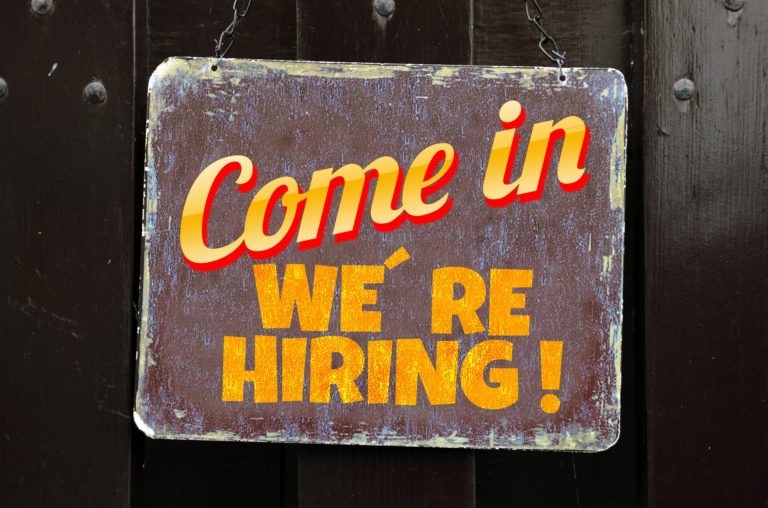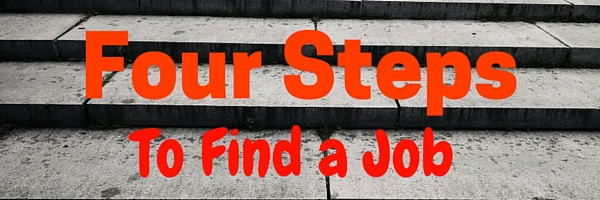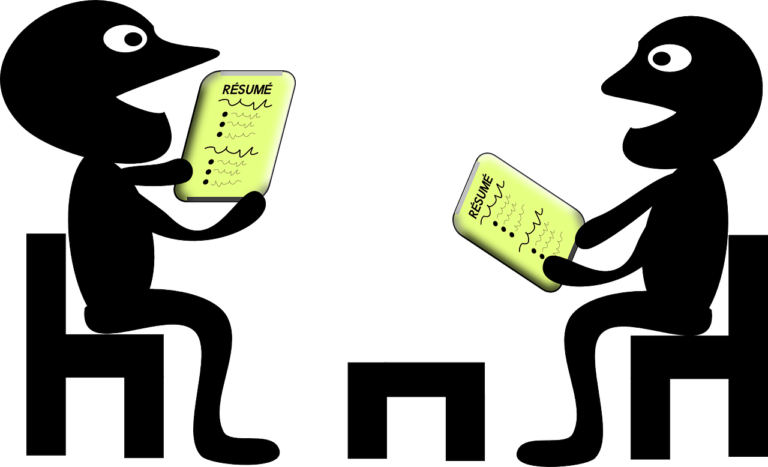Look, I know finding a job isn’t very fun. Starting a job search is like flossing your teeth, it’s extremely unpleasant, but it has to be done at some point.
Plus you’re bored and looking for a project to do, right? I know it’s not like having fun with one of your hobbies, but it’s at least productive time spent.
Thanks to the internet and other tools available to us, it doesn’t have to be very difficult to find a job or build a resume.
Additionally, it’s one of the best “projects” someone can undertake in their life when their bored and looking for things to do.

Finding a job has its obvious benefits (who doesn’t like having money?!), including solving any extra time issues you may have.
Getting a job is a huge time commitment, but one that must be done if you hope to survive in the real world.
Between the time it takes commuting to and from work, and putting in the hours of the job, you can easily spend 9+ hours of your day working.
Article Content:
Find a Job in 4 Easy Steps!

Finding a job really comes down to a few steps. These steps are very important, though, so don’t go through one and blow off one of these as easy. Remember, you’re trying to convince a business to hire you. If you were a business owner, would you want to hire a bum, or you and your awesome expertise and experience?
That’s what I thought. Alright so let’s review these steps to find a job!
- Gather all of your education, employment and awards information you may have.
- Create an amazing resume & setup an irresistible LinkedIn profile.
- Distribute your resume to job boards, employers and network of people you know is hiring.
- Interview with your job prospects and make employers love you
Gather All Relevant Information You Need to Build an Awesome Resume
Resumes are important because they showcase everything you need to inform an employer about yourself. There are many different types of information you’re going to want handy when we start writing our resume. If we ever want to find a job that’s worth working for.
It’s a slight project to gather all of this information, but it’s worth it if you want to find a job that you’ll love.
Let’s start by getting open a blank word document with MS Word or Google. Then in your blank document, you’ll want to start compiling all of the following information:
- Education
- Schools you attended (high school and above)
- Dates you attended.
- Degrees you’ve obtained
- Grade Point Averages
- School activities that you may have completed such as writing for the school newspaper.
- Special classes that others may not have taken that set you apart from other folks looking for a job
- Teachers that may give you a good reference
- Experience / Job History
- What jobs you’ve worked in the past
- Dates of employment
- Tasks you were assigned
- Awards or certificates obtained while working
- Job skills obtained while working for the employer
- Managers or coworkers that will give a good reference to your character
- Personal Skills
- Special and basic computer skills (proficient in MS Word, typing 50 words per minute, etc.)
- Foreign languages you may speak.
- Management or leadership accomplishments
Now I know this isn’t easy to get all of this information, but it’s extremely helpful to have this handy when we start actually writing our resume.
So you’re probably thinking, “Why wouldn’t I just start writing my resume on this already made document?”.
The answer? Formatting
Putting all of your personal information into a document and sending it off is NOT a resume. That’s a big mumbo jumbo collection of random facts that only you understand. We’ll be covering how to build your resume in the next section, so just hang tight!
Transform the Gathered Information into a Great Looking Resume

What’s exactly is a resume?
Well if you don’t already know, the definition of a resume is: “a brief written account of personal, educational, professional qualifications and experience, as that prepared by an applicant for a job.”
Alright so basically, a resume lets you want to brag about yourself. It explains in detail what you’ve done for work in the past (if any), what schooling or degrees you’ve acquired and pretty much anything in-between that you can think of that may seem attractive to a business looking to employ you.
Keep it simple stupid!
This is one of my all-time favorite acronyms I learned in school. KISS. Keep it simple stupid.
When you submit your resume and application to an employer, you don’t want them confused while they’re reviewing your information. Keep it simple stupid!
You’ll never find a job if your resume is full of fancy colors, weird letter fonts and overall craziness. Keep it very simple with a strong layout, and you’ll do just fine.
Programs I use when writing my resume:
- Google Docs
- Microsoft Word
- Open Office
- Any other word processor you may use for writing
Personally, I really enjoy Google Docs. It saves your progress real-time and provides a lot of simple tools to make your resume look awesome.
They also provide a resume template for you, if you’d like to follow their blueprint! 😉

Use bold Headers and Subheaders when writing your resume
Your resume is going to include a few different sections with a variety of information. It’s important to segment these out to make it easy to navigate and browse.
What do I mean? You want to structure your resume something like this:
- Title (biggest Text, “H1”)
- Work Experience (smaller text than title, but still large. “H2”)
- Previous employers
- Dates of employment
- Job duties and skills
- Education (smaller text than title, but still large. “H2”)
- Names of Schools
- Names of Degrees
- GPA
- Skills (smaller text than title, but still large. “H2”)
- Computer skills
- Foreign language
- References
- Reference name & contact info
- Reference name & contact info
- Reference name & contact info
- Work Experience (smaller text than title, but still large. “H2”)
See how easy that is to navigate? If you keep your resume simple, with easy to browse sections, you’ll find a job in no time!
Protip: Use bullets and other sectional friendly elements. It makes things very clear to the person reviewing your resume, and helps keep you organized at the same time!
Now I personally don’t care how pretty you make it. There are plenty of resume examples online, browse a few of them and see what format you like. Just remember that most, if not all of them, use a very basic format which will look similar to the example above.
Resume example guides:
- Livecareer
- Super-resume
- MS Word Resume Examples
Got an idea of how you want it to look? Good!
Let’s go over each section briefly as to what you should and should not include.
Necessary Sections of a Resume
Title / Header Section
This is the first section of your resume! You’ll want to make this section larger than the rest of your resume headings and text.
The reason for this is because it’s the first text an employer will look at. What’s more important than knowing who you are and how to contact you?
Information included in the title: Your Name (Largest text)
- Your Name (Largest text)
- Contact info (smaller text)
- Home Address (optional)
- Email Address
- Phone / Cell Phone #
Work Experience Section of Resume
Work experience is going to be another main section of your resume. If you want to find a job, this section is going showcase the jobs you’ve had previously.
This is extremely important to employers for a few reasons. It shows that you’ve been an employee before, plus any skills you’ve acquired through the years.
Honestly, I’m not going to tell you what information to include in this section of your resume. We covered it already when we gathered that information earlier, remember?
When entering your work experience, make sure you list is in reverse chronological order. Meaning list your most recent employer first, then continue down to your first job if applicable.
Information to include in your Work Experience section:
- Short and detailed descriptions of your previous job duties
- Include dates of employment
- Outcome of your work
- Try to limit your previous jobs to three, if possible
Work experience section guides:
Above all else, remember to be honest. Employers want an honest snapshot of the type of employee that you are.
When describing your previous work history, try to use power words as well. These words are exciting and actionable that will keep the employer reading your resume! You don’t want them to fall asleep on you, right?
Education Section of Resume
This particular section of your resume will be extremely important to half of you, and the other half you’re going to want to make this section disappear if you could.
Look, not everyone goes to college. It’s not for everyone, and some people just don’t have that opportunity to take advantage of. They’re looking for a job with just the experience they have in their back pocket.
There’s nothing wrong with that! You can find a job without a degree, it just might be more difficult and a bit more limited.
If you did go to college and graduated with a degree, great! This section will obviously tie in very closely with the particular job you’re in the market for.
Again, I’m not going to go over the particulars of this section. We already wrote down all of this information on our first document!
Information to include in your education section:
- Dates of attendance
- GPA if 3.0+ (consider including lower GPA if you were enrolled in a very challenging program)
- Awards/Honors earned
- Degrees and specialties
- Special courses completed that may be attractive to future employers
Education Section Resume Guides:
- Tips for education section
- How To (and How Not To) List Education on Your Resume
- Put your education to work on your resume
Skills Section of Resume
The skills section of your resume is optional but highly recommended. This section will describe any skills or qualifications you may have that couldn’t be covered in your education and work history sections.
If you want to find a job, you need to be unique! This section of your resume can be tailored or altered to fit the type of job your looking for.
Are you looking for factory positions? Post skills that would help you land that type of job!
These skills are going to be unique to you, and you only. Be specific with your details, and understand this will help make you look unique to your future employer.
Below is an example of my own resume. I was hoping to get a management position, so I included skills that highlight those strengths!

Skills Section Guides:
- Skill section writing guide
- Skills section in the resume guide
- 30 + Creative ways to list jobs skills on your resume
Protip: Want to get a few new skills to add to that resume? Check out udemy and learn some!
Optional Sections of a Resume
When writing your resume, you really want to keep it as simple as possible. This means getting straight to the point using the sections mentioned above: experience, education, skills, and your title/header.
However, maybe some of those sections are lacking in information. Or better yet, you have other qualifications that you want to highlight. Great!
Sections you can also include in your resume are:
- Objective
- Tells the prospective employer what type of work you’re currently looking for. This section is usually at the beginning of the resume, as the remainder of the document is going to help support this objective.
- Coursework
- If you took particular classes that pertain to the type of job you’re looking for, then definitely include that in your resume!
- Certifications or licenses
- Did you obtain a certification or license in a skill? You may want to include this information; especially if it relates to the position you want!
- Availability
- This would apply more to students looking for internships. List the timeframes you’re available to work that will adhere to your school schedule.
- Interests
- If the position you’re looking for is highly related to a personal interest of yours, then highlight that information! Example: man likes to fish and applies to work at an outdoor sports store. Of course, he’ll have a leg up on someone that doesn’t have an interest in the stores area of expertise!
Finishing Your Resume
Alright, so you’ve created your spectacular resume. Awesome!
Let’s review it and make sure everything is in place and ready to go before we submit it to employers that you target in your job search.
General Resume Tips
- Put your most important information “above the fold”
- This means putting what you want to highlight the most, first. Your name will always come first, obviously. But if your education is better than your work experience, put that first! Put your best stuff on the top half of the page to keep the employer reading more!
- Keep your resume to one page
- If you want to find a job, you need to keep the employer reading your resume. Unforunately they don’t want to read a novel. Keep your resume to a page if you can. If you absolutely need to go longer than that, you can.
- Make your contact information important
- We mentioned this earlier, but you definitely make sure they have the ability to contact you with your phone number and email address.
- Be Honest
- Just don’t lie on your resume. If lying gets you a job you’re not qualified for, you’ll be repeating this process over again shortly when you can’t perform the jobs duties. Find a job that you’re actually qualified for and just be honest!
- Use “power words”
- Don’t be boring! How many times have you read your own resume, and got bored of it? Now imagine someone reading it that has no idea who you are. Spruce up your words and keep them reading more!
- Avoid overly-used words
- Try using this guide to keep your from being “that guy”
- Proofread!!
- I mean this more than anything else here. If you have a typo on your resume, most employers will toss that beautifully written document in a heartbeat! Proofread everything and make sure it’s up to par.
Wrapping Your Resume Up and Create a LinkedIn Profile
Before we save our Resume, were going to want to create an awesome LinkedIn profile. Why should you do this?
According to this article published on the The Washington Post, 77% of employers are using your social media profiles to recuit potential employees.
Of that 77% of employers, 94% are relying on the social media website LinkedIn.
Create an Epic LinkedIn Profile Now
So what you want to do is head to LinkedIn.com and click sign up.
From here you’re going to want to go through and complete all of the steps they ask you to perform.
The document you created previously to write your resume will come in handy here. They’ll want your previous employers, dates, education information, etc.
There’s also a section for skills, your summary of achievements, and pretty much anything else that is relevant to a prospective employer.
Here are a few tips when completing your LinkedIn profile:
- Upload a professional photo
- This will be a first impression of the employer looking at your profile. Don’t use that mugshot of you at your best friends party. Oh yeah, don’t forget to smile. 🙂
- Add links to your website or blog
- Don’t have a website? Create one now!
- Ask for recommendations
- Did you know you can have a manager or colleague write you a recommendation? Reach out to them and have them brag about how awesome you are!
- Complete your profile completely
- This should be pretty explanatory, but fill out everything you can!
Upload Your LinkedIn Profile URL to Your Resume!
So you’ve gone ahead and created an awesome profile on LinkedIn! Good Job. Now we need to use it! It’ll help you find a job, I promise.
Under your contact information on your resume, include the URL of your LinkedIn profile. This will be an easy way for them to follow the link and find you on this social media giant.
Something Not Look Right On Your Resume?
If you’re still not happy with your resume, I have some help for you as well. There are a lot of resume building services out there to help you!
Check out a few of the resume services below and give them a try. They are well worth the money if you want some professional help when you need to find a job!
Highly Recommended Resume Builders:
- Resume Companion
- Resume Planet
- Resume Writers
Okay, so you have your brand spanking new resume! Save it as a PDF document & name it “Your name – Resume”.
Now the fun part starts, looking for a job and applying for a new position! Hang on tight, we’re going to find a job for you!
Applying for Jobs – Finding Places that are Hiring in Your Area
Okay so you’ve got your sparkly, new resume. Now what?
You need to find jobs in your area that are hiring!
Thankfully for us, the dawn of the internet has made this extremely easy. Long gone are the days of walking into a local business and asking for an application.
You can still do this, but applying for jobs online is just so much faster.
Find a Job By Submitting Your Resume Online to Job Boards
There are quite a few different online job finders. Personally, I only use two: Indeed.com and Careerbuilder.com
First off, these job board websites allow you to upload your resume directly to their website to allow employers to review it for themselves. Pretty cool, right?!
Secondly, they allow you to search for and apply for jobs you’re in the market for in your area.
The usual search criteria are:
- Zip code or City that you’re looking for work in
- What type of position
However, if you want a more specialized result, you can also search using advanced features.
Advanced search criteria are:
- Specific employers you want to find jobs for
- Category of position (accounting, sales, customer service, etc)
- Job postings by date
- Type of employment ( full-time, part-time, intern)
- Salary Range
Submitting Resume to Multiple Job Sites
Using Indeed and Careerbuilder will cover many of your bases. These are two of the most popular job posting websites in the world.
But they don’t cover everyone. You could spend days finding and submitting your resume to hundreds of job websites, all of which may have the employer you’ve been looking for. This is a pretty boring and labor intensive task in itself.
They are a great resource to have as they will submit that resume of yours to multiple job websites for you!
Alternative Ways to Find a Job
Find a Job with Craigslist
Have you tried Craigslist? Okay, okay…not the best place to look for employment in the world. But it’s a start isn’t it? Many employers do use Craigslist to find applicants. It’ll also give you an idea of what jobs are located in your local area.
The downside to using Craigslist is that a lot of scammers and spammers go on here as well. Make sure to keep this in mind when your browsing this website.
The plus side is they will never give away your personal email, as all messages go through Craigslist. Try it out and see what happens!
Let’s Take a Drive!
This is the oldest trick in the book when it comes to job hunting! Drive around town and look for “help wanted” or “hiring now” signs.
Make a list of them. You may even want to jot down the address or street you saw the business.
Now look them up online and find a “contact us” page or “career” section of the website. Shoot them an email with your resume attached and a brief description of who you are!
If the local business doesn’t have one of these pages, no problem! Print a copy of your resume and mail it off to them! Bonus points if you find a fax # and send it to them this method as well.
Job Fairs
Going to a job fair is one of the fastest ways of looking for employment. These are events held by multiple employers that are looking for applicants. These events are awesome when you need to find a job!
Attending one of these job fairs in your area is sure fire way of getting your resume in front of an employer, and you may even score an interview right there! Pretty awesome if you ask me!
Interviewing for Your Dream Job
So you got that wonderful call from an employer? Awesome!
Now comes the tricky part – interviewing!
There’s a lot that goes into attending and giving a great interview.
Personally, a few things pop into my head:
- Look and dress professionally
- Speak clearly and decisively
- Always make eye contact
- SMILE – show them those pearly whites
- First impressions are everything
Notice a trend here? Interviewing is all about making a good first impression!
The employer has already looked at your credentials. They know what you’ve done and accomplished so far when they reviewed your resume and profile.
They want to see that you match up!
Now am I saying that you have to only focus on your appearance and your body language during this process? No, absolutely not. But it’s a great place to start if you want to find a job you love.
Practice Makes Perfect When Job Hunting
There are quite a few questions that will be asked of you during this process. But the nice thing is, they don’t need to be a surprise.
Online there are quite a few guides advising of how to answer many of the popular and usual questions employers will ask their applicants.
Take a friend or family member, and do a mock interview! Below I’ve listed a few guides to help get you started!
Interview Question Guides
- Interview Questions & Answers
- How to Answer the 31 Most Common Interview Questions
- The Most Important Interview Questions and Answers
Find a Job – Conclusion
I hope this guide will benefit you greatly when you’re bored and looking for employement. I’ll post more guides on tips and tricks to getting a job, but for now share this article and comment below on the success you may have!
Cheers and happy job searching!

Hey Everyone!
Chritt here. I just want to say THANK YOU SO MUCH for visiting Boredom Busted. It’s been my passion project going on 7 years now.
I need a favor though. If you have found the page you landed on or explored useful in any ways – please please please share, or comment.
The more engagement on this page – the more I can continue to write and provide helpful content to my visitors like you.
I love you all and thank you again for visiting! Don’t be a stranger and hope to see you back, soon!

